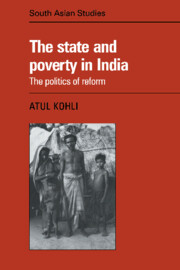Book contents
- Frontmatter
- Contents
- List of Tables and Figures
- Acknowledgements
- Introduction
- 1 The State and Redistributive Reforms
- 2 Democracy and Development in India: an Interpretation
- 3 West Bengal: Parliamentary Communism and Reform from above
- 4 Karnataka: Populism, Patronage, and Piecemeal Reform
- 5 Uttar Pradesh: Political Fragmentation, Middle-Peasant Dominance, and the Neglect of Reforms
- 6 Conclusion: The State and Reform in Democratic–Capitalist Development
- Appendix I On the Political Relevance of Social Classes in a Developmental Setting
- Appendix II Does Agriculture Growth Really “Trickle-down” in India?
- Bibliography
- Index
- CAMBRIDGE SOUTH ASIAN STUDIES
Appendix II - Does Agriculture Growth Really “Trickle-down” in India?
Published online by Cambridge University Press: 27 October 2009
- Frontmatter
- Contents
- List of Tables and Figures
- Acknowledgements
- Introduction
- 1 The State and Redistributive Reforms
- 2 Democracy and Development in India: an Interpretation
- 3 West Bengal: Parliamentary Communism and Reform from above
- 4 Karnataka: Populism, Patronage, and Piecemeal Reform
- 5 Uttar Pradesh: Political Fragmentation, Middle-Peasant Dominance, and the Neglect of Reforms
- 6 Conclusion: The State and Reform in Democratic–Capitalist Development
- Appendix I On the Political Relevance of Social Classes in a Developmental Setting
- Appendix II Does Agriculture Growth Really “Trickle-down” in India?
- Bibliography
- Index
- CAMBRIDGE SOUTH ASIAN STUDIES
Summary
Montek Ahluwalia concluded in an important article on India's rural development that “there is evidence of some ‘trickle down’ associated with agriculture growth.” The purpose of this appendix is to argue that the data presented by Ahluwalia can be interpreted in ways that would not support this conclusion.
Ahluwalia's general conclusion rests on his two specific prior conclusions: (1) Indian data do not indicate a trend increase in the incidence of rural poverty, and (2) the incidence of rural poverty is inversely related to agriculture performance, indicating that faster growth might have led to a reduced incidence of poverty. Both of these conclusions are debatable. The first of the two is somewhat more convincing because it is well supported; it nevertheless requires qualification. The second conclusion does not flow readily from the data presented.
Ahluwalia's data on the incidence of rural poverty in India do not disagree with the conclusion arrived at by Bardhan: from 1960 to 1968 there was a steady increase in the percentage of the rural population living below the poverty line. The time series data for these years only reconfirm this finding. The interesting issue then arises as to what has been happening to poverty since the late 1960s. Ahluwalia provides data for three more years, namely, 1968-9,1970-1, and 1973-4. These years do not fit into the trend discerned by Bardhan. On the contrary, the trend appears to be reversed. However, does this amount, as Ahluwalia would have it, to a negation of the earlier evidence? It is possible to interpret the data in a somewhat different way.
- Type
- Chapter
- Information
- The State and Poverty in India , pp. 242 - 244Publisher: Cambridge University PressPrint publication year: 1987



